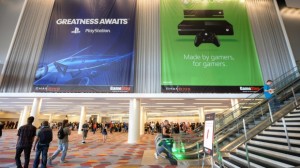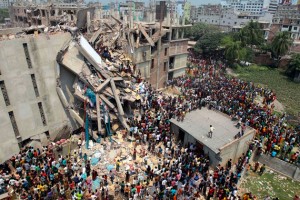
Banners for the Sony PS4 and Xbox One gaming systems hang at the GameStop Expo in Las Vegas in August. The two systems will be commercially available this month.
Sony’s launch of its PlayStation 4 on November 13th has added more heat to the already-hot market of gaming consoles, selling more than a million units within the first 24 hours. The fire is sure to get even hotter with the impending release of Microsoft’s Xbox One. According to CBC.ca’s coverage of the launches, “PlayStation 4 vs. Xbox One Review: How They Match Up” at, it appears that two big questions, “Which one should I buy?” and “What’s the difference?” are what console buyers are asking. Both platforms show big improvements in the fidelity of how graphics are rendered, with both displaying major advances over their respective previous versions. Some elements are difficult to compare because they rely on the personal preferences and discrimination of each player. For example, stone walls and riverbeds in Call of Duty looked good on the old Xbox 360, but on the Xbox One they pop into three dimensions. A head-to-head comparison of the two platforms produces no huge difference between them because Sony and Microsoft use different approaches for gamers. The PS4 serves up a great controller and slightly better graphics at a lower price point, while the Xbox One offers more big games up front, with at least one of them likely to become a blockbuster. The two approaches demonstrate the importance of offering points of parity that ensure that each product meets the specifications that are required to be a contender in the market, yet also establish worthwhile points of difference that set each of them apart for the purpose of brand positioning and value proposition. We will see, as the holiday season plays out, which platform wins the hearts and minds of more consumers. Looks like it’s game on!
Reference: Nowak, Peter. “PlayStation 4 vs. Xbox One Review: How They Match up – Technology & Science – CBC News.” CBCnews. CBC/Radio Canada, 13 Nov. 2013. Web. 18 Nov. 2013. <http://www.cbc.ca/news/technology/playstation-4-vs-xbox-one-review-how-they-match-up-1.2424315?cmp=rss>.

